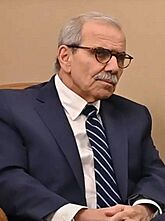Prime Minister of Lebanon facts for kids
Quick facts for kids President of the Council of Ministers of Lebanon |
|
|---|---|

Logo of the Presidency of the Council of Ministers of the Lebanese Republic
|
|
| Style | His/Her Excellency |
| Member of | Council of Ministers |
| Residence | Grand Serail, Beirut |
| Nominator | Parliament |
| Appointer | President |
| Inaugural holder | Auguste Adib Pacha 31 May 1926 |
| Formation | Constitution of Lebanon 23 May 1926 |
| Deputy | Deputy Prime Minister of Lebanon |
| Salary | £L212,844,000/US$ 3,547 annually |
| Website | Lebanese Government Website |
The prime minister of Lebanon is also known as the president of the Council of Ministers. This person is the main leader of the government and the head of the Council of Ministers in Lebanon. The president of Lebanon chooses the prime minister. This choice needs to be approved by most members of the Parliament of Lebanon.
Since 1990, after an agreement called the Taif Agreement, this process became official. Also, by tradition, the person holding this job is always a Sunni Muslim.
The current prime minister is Nawaf Salam. He was asked by President Joseph Aoun to form a new government. This happened on January 13, 2025, after many discussions in Parliament. Mr. Salam received 84 out of 128 votes. A prime minister officially starts their job only after they and the president sign a special document. This document officially creates the new government. On February 8, 2025, the new government was formed. Nawaf Salam then officially became the prime minister of Lebanon.
The prime minister gets help from the deputy prime minister. As of February 8, 2025, the deputy prime minister is Tarek Mitri.
Contents
History of the Prime Minister's Role
The job of prime minister was created on May 23, 1926. This was when the first constitution for Greater Lebanon was put into action. In 1943, a special agreement called the National Pact was made. It decided that the prime minister's job would always be for a Sunni Muslim.
For many years, the constitution did not clearly explain the prime minister's duties. Most of their power came from unwritten rules. After the Lebanese Civil War ended, the Ta'if Accord was approved. This agreement clearly wrote down all the prime minister's responsibilities in the Constitution.
How the Role Changed Over Time
The 1926 Constitution of Greater Lebanon was similar to the French constitution. However, the prime minister in Lebanon had less power than in France. In Lebanon, the president could remove the prime minister at any time. In France, the prime minister could only be removed by the Parliament. This meant the Lebanese prime minister had to follow the president's wishes more closely.
This situation changed after the Taif Agreement. Lebanon became a parliamentary republic. Now, the president chooses the prime minister who has the most support from Parliament members. The prime minister must then create a government that Parliament trusts and the president agrees with. Once the government is approved, the prime minister can only be removed if Parliament no longer trusts them.
Past Changes in Leadership
There were two times in the past when the president did something unusual. When a president resigned or was about to finish their term, they appointed a Maronite Christian as prime minister. This was against the National Pact. The reason given was that this person would take over the president's powers.
First, in 1952, Bechara El Khoury was president. Just before he resigned, he appointed Fouad Chehab as prime minister. Chehab was prime minister for 13 days and acting president for 4 days. When Camille Chemoun became the new president, the prime minister's job went back to a Sunni Muslim, Khaled Chehab.
Later, during the Lebanese Civil War, outgoing president Amine Gemayel dismissed the prime minister, Selim Hoss. He then appointed Army general Michel Aoun as prime minister. This happened just 15 minutes before his own term ended. Hoss refused to accept his dismissal. This led to two separate governments. One was mainly civilian and Muslim in West Beirut. The other was mainly military and Christian in East Beirut.
Prime Minister's Responsibilities and Powers
The prime minister leads the Council of Ministers and is the head of the government. They are also the deputy leader of the Supreme Defense Council.
Here are the main jobs of the prime minister:
- They lead the discussions to form a new government with Parliament.
- They must sign all official orders that the president signs. The only exceptions are the order appointing them or the one saying the government has resigned.
- They present the government's plans to the Chamber of Deputies (Parliament).
- They lead the meetings of the Council of Ministers. If the president attends, the president leads, but the prime minister is still in charge of the agenda.
- If the president's job becomes empty for any reason, the prime minister takes over the president's duties. This means they handle the day-to-day running of the country.
Symbolic Duties of the Prime Minister
After the Ta'if Accord, the Constitution added a special introduction. It described the roles of the president, the prime minister, and the Council of Ministers.
It states:
The Prime Minister is the Head of Government. He represents it, speaks in its name, and is responsible for executing the public policy made by the Council of Ministers.
The prime minister also holds these important positions automatically:
- Vice President of the Supreme Defense Council
- President of the Council of Ministers
- Head of the government
More Information
- President of Lebanon
- Legislative Speaker of Lebanon


